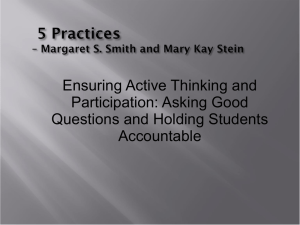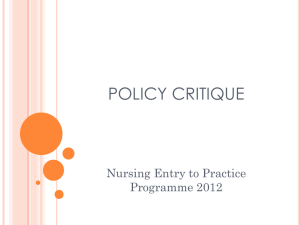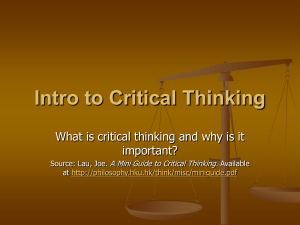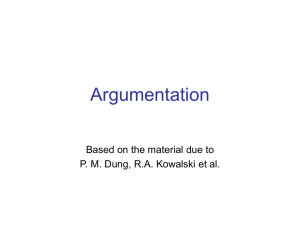Slides
advertisement
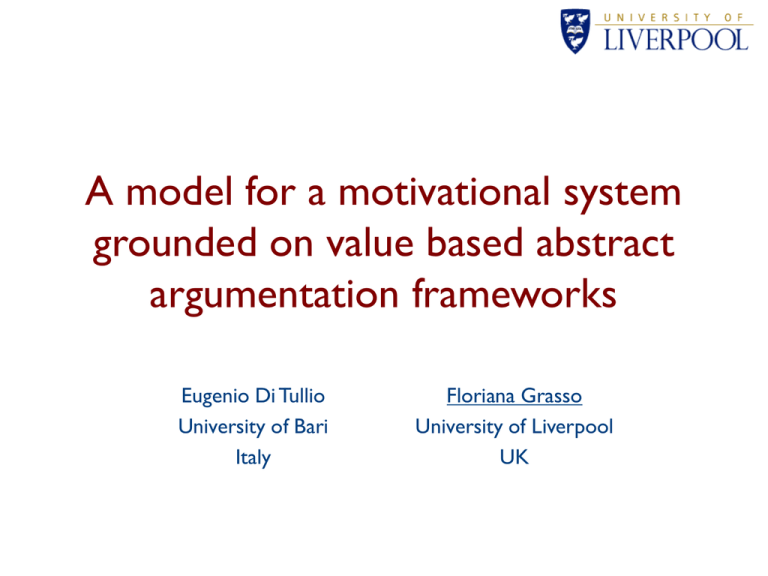
A model for a motivational system grounded on value based abstract argumentation frameworks Eugenio Di Tullio University of Bari Italy Floriana Grasso University of Liverpool UK The problem • Digital interventions to promote healthy lifestyles • More successful if grounded in robust behavioural theory – Variety of techniques to impact different stages of the planning process – Use of different styles of interaction • New insights from recent research areas in AI: – Persuasion technology – Argumentation Theory Argument & Computation • Over the last decade a core and autonomous discipline within AI, as opposed to permeating reasoning research – Emphasis on what persuades, not proofs – Hypothesis that the extent of acceptance is subjective, depending on the view of the audience • Crucial aspect within practical reasoning, as opposed to theoretical reasoning – Presumptive schemata – Embraced by recent research in MultiAgent Systems Application areas • Multi-agent dialogue interactions – E.g. negotiation scenarios • Legal reasoning – E.g. tools to model and support case-based reasoning • Healthcare advice – E.g. changing attitudes to healthy eating • Medical treatment – E.g. automated argument over organ transplants • Finance – E.g. automated stock market exchanges/contract Directions of research • Abstract argument systems: formal exploitation of simple notions of “attack” and “defense”. • Logics for argumentation: formal models for automated reasoning. • Dialogue protocols: emphasis on the rules that should govern the argumentation process and the participants to it. • Argument schemes: stereotypical patterns for presumptive reasoning, fallacies. Abstract Argumentation An argumentation framework (AF) is a pair F = (A, R) where A is a set of arguments R ⊆ A × A is a relation representing “attacks” or “defeats”. Different semantics to establish which arguments are “in” and which are “out”. Transtheoretical model of change Motivational dialogues • A subclass of argumentative dialogues • Main feature: a discussion around a behaviour, and the considerations of pros and cons of such behaviour – Can’t be based on “facts” only – Highly entrenched in the “value system” of the parties engaging in the discussion – There is no right or wrong answer – things change when perspectives change Example A1:You should exercise twice a week because it improves your health. B2: Why is it good for my health? A3: Because exercise improves your stamina. B4: But then I might as well go to work by bike. A5: No, exercising is better for your health. B6: But exercise is boring. A7: What is more important: your health or having fun? B8: I find my health is more important. I guess I should exercise. (from van der Weide et al 2010 “Practical Reasoning Using Values”) Practical Reasoning on Values and Perspectives • Values: “desirable trans-situational goals, varying in importance, that serve as guiding principles in the life of a person or other social entity” Schwartz,S, Advances in experimental social psychology 25 (1992) • Value Based Argumentation Framework (VAF) (Bench-Capon et al, Argumentation Research Group, University of Liverpool) – Tuple <AR, attack,V, val, P> – AR set of arguments; attacks relation on AR,V set of values, val function mapping from AR to V P set of possible audiences. – An argument relates to value v if accepting it promotes or defends v. Practical Reasoning on Values and Perspectives -ctd • Values are discussed in terms of what condition promotes or demotes them – E.g. treating people the same promotes the value of equality, exercising promotes the value of being healthy • Conditions and values can be promoted in degrees – Not exercising is not healthy, exercising once a month is healthier, once a week is healthier still • Perspective: preorder on states representing a “topic” for discussion (e.g. health, fun) Practical Reasoning on Values and Perspectives -ctd • Perspectives can positively or negatively influence other perspectives forming chains – (E.g. health positively influence wellbeing) • When an agent has a “preference” over a perspective, this perspective becomes a “value” – used as a “guiding principle” by the agent – agent will try to reach as state maximally preferred from that perspective Example Health, Fun and Conformity perspectives are also values Exercise perspective is not a value, but influences values (from van der Weide et al 2010 “Practical Reasoning Using Values”) Motivational System • Ultimate aim: – Build an environment for digital interventions, based on motivational dialogues – Authoring tools for creating user profiling, communication plans/strategies, styles of interaction – Mobile technology to acquire user’s preferences and lifestyles – Centred around the notion of “Value System” Prototype implementation • A prototype built on top of Aspic (Argumentation Service Platform with Integrated Components - 6FP - Opensource) – A platform to manage argumentation dialogues, which also provides services like reasoning, decision-making, learning. • Concentrates on the managing of the value system and the practical reasoning on perspectives – Left aside: user’s profiling and behavioural strategy implementation System architecture Value System Ontology Managing values • Two value systems are maintained – For the user and for “the system” – Typical for dialogue systems representing “mutual” beliefs • Interaction driven by a plan or “strategy” based on the user’s behavioural profiling (e.g. Transtheoretical model) – E.g. topic of discussion based on the stage of change • System attempts to “utilise” user’s own beliefs and value system to maximise motivation impact Example • The system contains the states: 1. Eating junk food less than 4 times a month; 2. Eating junk food between 4 and 8 times a month; 3. Eating junk food more than 8 times a month • And the perspectives to evaluate the states are Healthy eating; Fitness; Health; Social life • Initial value systems are: Evaluation of Transition A • System attempts to make user “aware” of influences which could impact the evaluation of transition A New evaluation of A New connections Screenshot Conclusions • Preliminary work towards an argumentation based motivational system • Attempt to combine insights from argumentation theory and behavioural theories • Still prototypical: need to include more reliable user model and full blown communication strategies • Adherence to standards (e.g. Aspic) looks beneficial in terms of cross-discipline evaluation



